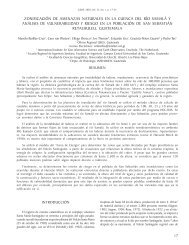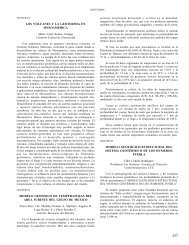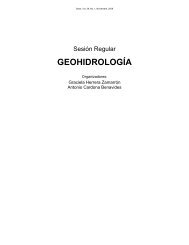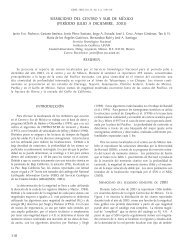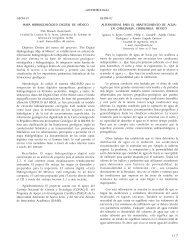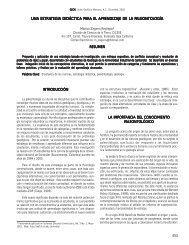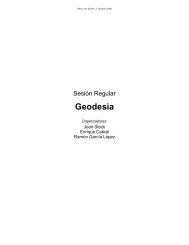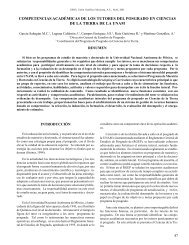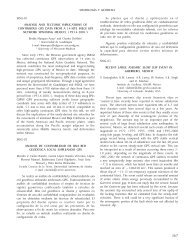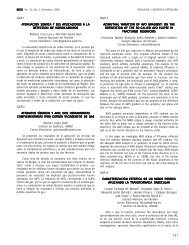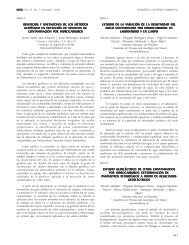Libro de Resúmenes - Unión Geofisica Mexicana AC
Libro de Resúmenes - Unión Geofisica Mexicana AC
Libro de Resúmenes - Unión Geofisica Mexicana AC
Create successful ePaper yourself
Turn your PDF publications into a flip-book with our unique Google optimized e-Paper software.
Geos, Vol. 30, No. 1, Noviembre, 2010<br />
EXTENSIÓN Y MAGMATISMO DURANTE LA RUPTURA CONTINENTAL EN EL<br />
GOLFO DE CALIFORNIA<br />
SE14-4<br />
ORIGEN DEL GOLFO DE CALIFORNIA COMO UNA ZONA<br />
EXTENSIONAL RETROARCO DEL MIOCENO MEDIO<br />
Ferrari Luca 1 , López Martínez Margarita 2 , Orozco Esquivel<br />
Teresa 1 , Duque Trujillo José 1 y Cerca Martínez Mariano 1<br />
1 Centro <strong>de</strong> Geociencias, UNAM<br />
2 Departamento <strong>de</strong> Geología, División <strong>de</strong> Ciencias <strong>de</strong> la Tierra, CICESE<br />
temperatures substantially in this way. Preliminary numerical experimentation<br />
shows that the melt fraction could reach up to 10% and the maximum amount<br />
of shear heating could lead to a temperature increase close to 200 °C at 35<br />
km <strong>de</strong>pth. Moreover, the rise of magmas and/or hot fluids in the shear zone<br />
will enhance the temperature increase in shallower parts, further promoting the<br />
production of melt.<br />
SE14-6<br />
luca@geociencias.unam.mx<br />
La fase inicial <strong>de</strong> rifting en el Golfo <strong>de</strong> California ha sido consi<strong>de</strong>rada como<br />
un proceso que ocurrió en el Miocene tardío don<strong>de</strong> la interacción entre las<br />
placa <strong>de</strong>l Pacifico y la <strong>de</strong> Norteamerica fue acomodado por medio <strong>de</strong> una<br />
partición entre una <strong>de</strong>formación lateral <strong>de</strong>recha a lo largo <strong>de</strong>l sistema <strong>de</strong> fallas<br />
Tosco-Abreojos al occi<strong>de</strong>nte <strong>de</strong> Baja California y una extensión ortogonal al<br />
este, en la llamada Provincia Extensional <strong>de</strong>l Golfo (PEG) (Stock and Hodges,<br />
1989). En este mo<strong>de</strong>lo la extension inicial en la región <strong>de</strong>l Golfo ocurriría solo en<br />
el Mioceno Tardío, <strong>de</strong>spués <strong>de</strong>l cese <strong>de</strong> la subduction afuera <strong>de</strong> Baja California<br />
a los ~12.5 Ma. Nuestro estudio <strong>de</strong> la geología <strong>de</strong>l occi<strong>de</strong>nte <strong>de</strong> Nayarit y<br />
Sinaloa soportada por geocronología Ar-Ar y mo<strong>de</strong>los físicos a escala apunta<br />
a un inicio mas temprano <strong>de</strong>l proceso <strong>de</strong> rifting en la parte sur <strong>de</strong>l Golfo. El<br />
limite oriental <strong>de</strong> la Provincia Extensional <strong>de</strong>l Golfo en Nayarit y en Sinaloa<br />
esta conformado por una franja <strong>de</strong> hasta 50 km <strong>de</strong> fallas extensionales <strong>de</strong> alto<br />
angulo <strong>de</strong> dirección <strong>de</strong> N-S a NNO-SSE que afecta la parte Oeste <strong>de</strong>l plateau<br />
ignimbritico <strong>de</strong> la Sierra Madre Occi<strong>de</strong>ntal (SMO). Este sistema <strong>de</strong> fallas está<br />
segmentado en dominios <strong>de</strong> 130 a 190 km <strong>de</strong> largo con vergencia opuestas<br />
separados por zonas <strong>de</strong> transferencias perpendiculares. El basculamiento <strong>de</strong><br />
bloques es hacia el ENE en el norte <strong>de</strong> Sinaloa y el norte <strong>de</strong> Nayarit, mientras<br />
que se vuelve ONO en el sur <strong>de</strong> Sinaloa, entre El Rosario y Piaxtla. La edad <strong>de</strong><br />
esta franja extensional <strong>de</strong> dirección NNO está limitada por un pulso regional <strong>de</strong><br />
volcanismo máfico geoquimicamente uniforme distribuido casi continuamente a<br />
lo largo <strong>de</strong> la parte oriental <strong>de</strong> la PEG <strong>de</strong>s<strong>de</strong> Punta Mita, Nay., hasta Sonora.<br />
Este volcanismo está conformado por enjambres <strong>de</strong> diques <strong>de</strong> dirección NNO<br />
y coladas <strong>de</strong> lava horizontales que yacen en discordancia angular sobre los<br />
bloques basculados <strong>de</strong> la SMO. La edad <strong>de</strong> este volcanismo ha sido claramente<br />
establecida por un gran número <strong>de</strong> eda<strong>de</strong>s K-Ar y Ar-Ar entre ~12 y 10 Ma.<br />
Las lavas basalticas están emplazadas casi a nivel <strong>de</strong>l mar, lo que indica un<br />
<strong>de</strong>splazamiento vertical mínimo <strong>de</strong> 2.2 km <strong>de</strong> las ignimbritas <strong>de</strong> la SMO, cuyas<br />
eda<strong>de</strong>s Ar-Ar mas recientes son <strong>de</strong> 18.7 Ma. Estos resultados son consistentes<br />
con el inicio <strong>de</strong> la actividad <strong>de</strong> la falla extensional <strong>de</strong> Los Cabos en la parte mas<br />
meridional <strong>de</strong> Baja California, don<strong>de</strong> las rocas <strong>de</strong>l bloque <strong>de</strong> piso indican un<br />
enfriamiento rapido por exhumación antes <strong>de</strong> ~10 Ma (Fletcher et al., 2000) y los<br />
sedimentos mas antiguos en la cuenca asociada tienen una edad paleontologica<br />
<strong>de</strong>l Mioceno medio. El establecimiento <strong>de</strong> una edad Mioceno medio para el inicio<br />
<strong>de</strong> la extensión en la PEG implica que este evento tectónico coincidió con el<br />
<strong>de</strong>sarrollo <strong>de</strong>l arco an<strong>de</strong>sitico Comondú mas al oeste. En este caso el inicio <strong>de</strong>l<br />
proceso <strong>de</strong> rifting habría ocurrido en un ambiente <strong>de</strong> retroarco durante el estadio<br />
final <strong>de</strong> la subducción <strong>de</strong> la placa Farallón.<br />
SE14-5<br />
VISCOUS DISSIPATION AS A REGIONAL THERMAL ANOMALY-<br />
GENERATOR PROCESS: IMPLICATIONS ON THE EVOLUTION<br />
OF BAJA CALIFORNIA POST-SUBDUCTION VOLCANISM<br />
Negrete Aranda Raquel y Contreras Juan<br />
División <strong>de</strong> Ciencias <strong>de</strong> la Tierra, CICESE<br />
rnegrete@cicese.mx<br />
An intriguing feature of the Baja California peninsula is that volcanic activity<br />
thrived and continued along the axis of the peninsula even after the cessation of<br />
subduction 10 Ma ago. Post-subduction volcanism in Baja California occurred<br />
mainly in monogenetic volcanic fields comprising a variety of compositions,<br />
most of them associated with high-temperature regimes and marked by a<br />
“slab” signature (i.e., adakites, Niobium-enriched basalts and high-magnesium<br />
an<strong>de</strong>sites).<br />
Several attempts have been ma<strong>de</strong> to explain the origin and compositional<br />
diversity of such post-subduction volcanism. Many of them rely on the<br />
assumption that anomalous magmas are formed in direct response to tectonic<br />
events such as slab window formation or slab-tearing processes. However, none<br />
of them can offer a satisfactory explanation as to why volcanism as young as 1<br />
Ma can be found along the Baja California peninsula. Observations elsewhere<br />
and in numerical simulations have shown that the slab tearing process is a fast<br />
one lasting only a few million years. By contrast the post-subduction volcanism<br />
in Baja California has lasted more than 10-million years.<br />
Here, we present a physical mo<strong>de</strong>l that shed light into the origin of this<br />
controversial phenomenon. The mo<strong>de</strong>l calls upon viscous dissipation or shear<br />
heating as the process responsible for the generation of a regional heat flow<br />
anomaly with a maximum amplitu<strong>de</strong> of 40 mW/m2 clearly observed in <strong>de</strong>ep<br />
boreholes drilled in the area. We hypothesize that at mo<strong>de</strong>rate <strong>de</strong>pths it may<br />
have caused partial melting after the cessation of subduction along the Baja<br />
California. Our results show that in<strong>de</strong>ed is possible for rocks to increase their<br />
ANALOGUE MODELS OF OBLIQUE RIFTING<br />
EVOLUTION OF THE GULF OF CALIFORNIA<br />
Cerca Martínez Mariano 1 , Corti Giacomo 2 , Ferrari Luca 3 y Portillo Pineda Rodrigo 4<br />
1 Laboratorio <strong>de</strong> Mecánica Multiescalar <strong>de</strong> Geosistemas, Centro <strong>de</strong> Geociencias, UNAM<br />
2 CNR-IGG, Sezione di Firenze, La Pira, 4 – 50121 Firenze, Italy<br />
3 Centro <strong>de</strong> Geociencias, UNAM<br />
4 Posgrado en Ciencias <strong>de</strong> la Tierra, Centro <strong>de</strong> Geociencias, UNAM<br />
mcerca@geociencias.unam.mx<br />
The complex fault kinematics resulting from the phase of high oblique rifting<br />
(ca. 70°) of the Gulf of California, before the rupture and establishment of<br />
spreading segments and after a continued history of extension beginning in<br />
the Late Oligocene (see Ferrari et al., this session), were investigated through<br />
lithosphere-scale physical mo<strong>de</strong>ls of two types: a) mo<strong>de</strong>ls in a large-capacity<br />
centrifuge were performed at the Tectonic Mo<strong>de</strong>ling Lab in Florence (scale<br />
1cm=40 km); and b) “normal” gravity mo<strong>de</strong>ls were ma<strong>de</strong> in the Laboratorio<br />
<strong>de</strong> Mecánica Multiescalar <strong>de</strong> Geosistemas (scale 1cm=25 km). In both cases,<br />
we simulated the upper brittle crust, lower ductile crust, and upper lithospheric<br />
mantle of the continental lithosphere (50 km) floating above a low viscosity fluid<br />
simulating the asthenosphere. The area rifted was simulated alternatively with<br />
a band or a plate of relatively weaker materials. The contact between strong<br />
and weak materials is characterized by a trace oriented at an angle of 70° with<br />
respect to the direction of extension, and its geometry simulated an interpreted<br />
en-echelon pattern of bor<strong>de</strong>ring faults. Deformation of the mo<strong>de</strong>ls was driven by<br />
displacement of the strong plate simulating the Baja California Block resulting<br />
in asymmetric rifting and strong localization of the <strong>de</strong>formation at the western<br />
Gulf bor<strong>de</strong>r. The mo<strong>de</strong>l results show the <strong>de</strong>velopment of faults with dip-slip<br />
and/or oblique-slip kinematics forming <strong>de</strong>pressions where the crust is highly<br />
attenuated. Dip-slip faults predominate in an en-echelon pattern slightly oblique<br />
with respect to the extension direction and strike-slip faults have a high angle<br />
with respect to the extension direction. The first or<strong>de</strong>r results for centrifuge and<br />
normal gravity mo<strong>de</strong>ls are similar in spite of differences in the lenght and quantity<br />
of the faults formed. The comparison of the experimental results with the faults<br />
patterns observed in the southern Gulf of California suggest a similar evolution.<br />
These findings might indicate that the geometry of the spreading segments was<br />
inherited from the initial segmentation of the bor<strong>de</strong>r faults and emphasize the<br />
role of extension in localizing magma ascent at the more attenuated basins.<br />
SE14-7<br />
RUPTURA CONTINENTAL CONTROLADA POR FALLAS<br />
NORMALES DE BAJO ÁNGULO EN EL NORTE DEL GOLFO DE<br />
CALIFORNIA; ANÁLISIS DE PERFILES SÍSMICOS DE REFLEXIÓN<br />
Martín Barajas Arturo 1 , González Escobar Mario 1 , Fletcher<br />
John 1 , Pacheco Romero Martín 1 y Mar Hernán<strong>de</strong>z Eduardo 2<br />
1 CICESE<br />
2 Instituto Tecnológico <strong>de</strong> Ciudad Ma<strong>de</strong>ro<br />
amartin@cicese.mx<br />
La transición entre extensión continental y ruptura <strong>de</strong> la litosfera en el norte<br />
<strong>de</strong>l Golfo <strong>de</strong> California se observa a través <strong>de</strong> las cuencas conjugadas Tiburón<br />
y Delfín. La interpretación <strong>de</strong> una malla sísmica <strong>de</strong> 5 a 20 km <strong>de</strong> separación<br />
propiedad <strong>de</strong> PEMEX permitió i<strong>de</strong>ntificar y correlacionar las fallas principales y<br />
los patrones <strong>de</strong> fallas secundarias. Nuestra interpretación indica que gran parte<br />
<strong>de</strong> la extensión oblicua se acomoda en fallas normales lístricas <strong>de</strong> orientación<br />
NNE que convergen a profundidad a una superficie <strong>de</strong> <strong>de</strong>spegue que llamamos<br />
<strong>de</strong>tachment Angel <strong>de</strong> la Guarda (DAG). La falla lístrica principal <strong>de</strong>l sistema<br />
<strong>de</strong> <strong>de</strong>tachment es ~60 km <strong>de</strong> largo, es cóncava hacia el sureste y se vuelve<br />
subhorizontal por <strong>de</strong>bajo <strong>de</strong> los 3 segundos (TWTT). El <strong>de</strong>tachment yuxtapone<br />
la secuencia marina <strong>de</strong>l Mioceno-Plioceno sobre el basamento acústico que<br />
interpretamos como corteza continental a<strong>de</strong>lgazada. En sus dos extremos el<br />
<strong>de</strong>tachment Ángel <strong>de</strong> la Guarda está unido a la falla De Mar al oriente y<br />
a la falla Tiburón al occi<strong>de</strong>nte, dos fallas <strong>de</strong>strales <strong>de</strong> orientación NW que<br />
cortan la corteza continental <strong>de</strong> ambas margenes con orientación subparalela<br />
al transporte tectónico. La interpretación sísmica también indica que parte <strong>de</strong><br />
la cizalla <strong>de</strong>recha a través <strong>de</strong>l rift ocurrió en una franja <strong>de</strong> ~30 a 40 km <strong>de</strong><br />
ancho en el margen <strong>de</strong> Sonora ahora inactivo. El DAG está cortado por un<br />
patrón <strong>de</strong> fallas <strong>de</strong> orientación NE con caída al NW hacia las cuencas Delfín<br />
Inferior y Delfín Superior separadas <strong>de</strong> la cuenca Tiburón por un alto estructural<br />
formado por el levantamiento <strong>de</strong>l bloque <strong>de</strong> piso <strong>de</strong> DAG. En las cuencas Delfín<br />
numerosas intrusiones volcánicas en la zona axial indican la ruptura incipiente<br />
<strong>de</strong> la litosfera continental y la formación <strong>de</strong> una corteza hibrida <strong>de</strong> origen<br />
193



![Libro de resúmenes [revisión final, 172 páginas] - UGM](https://img.yumpu.com/51565067/1/190x245/libro-de-resamenes-revisian-final-172-paginas-ugm.jpg?quality=85)
